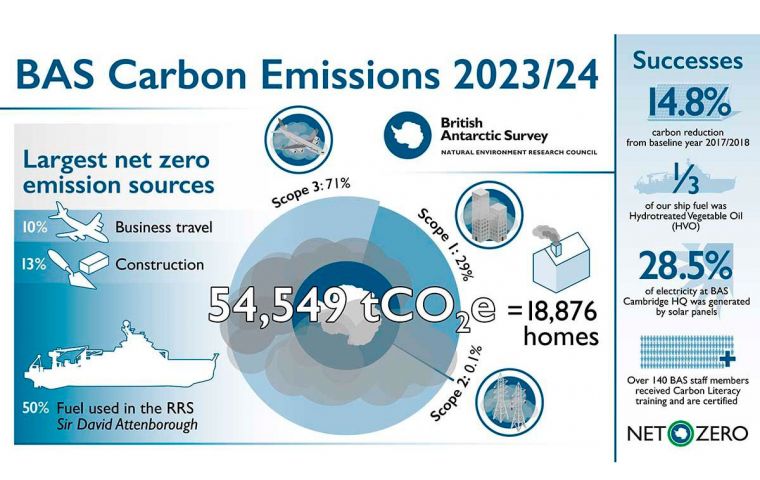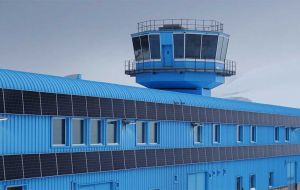MercoPress. South Atlantic News Agency
BAS publishes carbon emissions for 2023/24, striving to reach net zero
 Infographic explaining BAS Carbon Emissions
Infographic explaining BAS Carbon Emissions For the first time, the British Antarctic Survey (BAS) are publishing their carbon footprint data on their website to increase transparency and help other organizations reduce their carbon emissions.
The data for 2023/2024 includes an assessment of emissions from the five BAS Antarctic stations, the RRS (Royal Research Ship) Sir David Attenborough, fleet of aircraft and travel to and from Antarctica for staff and logistics. We plan to publish the data annually from now on.
BAS is striving to reach net zero, and considerable progress has been made in the last year. The successful trial of alternative fuels and using Hydro-treated Vegetable Oil (HVO) on board the RRS Sir David Attenborough, led to it constituting 1/3 of the ship fuel. A new solar and energy plant was installed in the remote island of South Georgia at Bird Island Research Station, which once operational will cut emissions by 50% on station.
BAS is also up skilling their staff to look at ways to cut carbon emissions. Carbon literacy training empowers people to find ways to reduce carbon both at work and in their communities. BAS has now trained over 140 colleagues in the past year and was certified as a Bronze Carbon Literate organization. They are also one of the first public sector organisations, along with partner body UKRI-NERC, to be recognized as ‘taking action’ under the Carbon Trust Route to New Zealand Standard.
BAS’s total carbon footprint for 2023/2024 is 54,549 tCO2e the equivalent of running 18,876 average UK homes for a year. For the measurable emissions (relating to their net zero target from scope 1, scope 2 and some scope 3 emissions) over half of the carbon emissions (50.57%) was from fuel used in the RRS Sir David Attenborough.
Construction is the second largest contributor (12.86%) and includes greenhouse gases from constructing new Antarctic facilities to replace old and inefficient buildings. Business travel is the next largest contributor (9.6%), including travel to and from Antarctica, along with travel to conferences and events.
Dr Beatrix Schlarb-Ridley, Director of Innovations and Impact at British Antarctic Survey said: “Our planet is changing rapidly, the Arctic is warming up four times as fast as the global average and accelerated melting of Antarctic ice shelves contributes to sea level rise, which threatens livelihoods, infrastructure and hits those hardest who are most vulnerable.”
As a research-driven organization, we are publishing our carbon data not only for transparency, but also to encourage other organizations on their own journey to net zero. We work in collaboration with industry, researchers and policy makers to help us understand our changing planet and we value input from other organizations on how we can cut emissions to protect the planet.”
Nopi Exizidou, Head of Net Zero Transition Lead said: “BAS provides the UK’s national polar capability by operating research stations, aircraft, and Royal Research Ship Sir David Attenborough. Since we work in such a remote and harsh environment, we are on a challenging journey to reach net zero emissions, but we are determined to put environmental sustainability at the heart of everything we do.” (BAS).





Top Comments
Disclaimer & comment rulesCommenting for this story is now closed.
If you have a Facebook account, become a fan and comment on our Facebook Page!